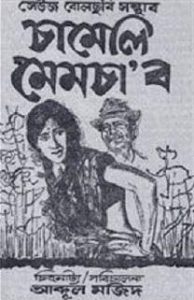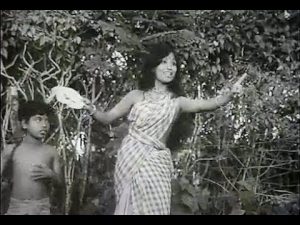Sneha Khaund is a PhD student in the Comparative Literature program at Rutgers University. She graduated with an MA in Comparative Literature from the Centre for Cultural, Literary and Postcolonial Studies at SOAS in 2016. Her research interests lie in writing from Northeast India and decolonial Caribbean theory.
Sneha’s piece “The Writing of Assamese Identity in Nirode Chaudhury’s ‘Chameli Memsaab'” is a winner of MULOSIGE’s Review and Publish project. You can watch the song that Sneha writes about here.
The Writing of Assamese Identity in Nirode Chaudhury’s “Chameli Memsaab”

Photo by Aniketh Kanukurthi on Unsplash

Assamese film poster
অসম দেশৰ বাগিছাৰে ছোৱালী
ঝুমুৰ-তুমুৰ নাচি কৰো ধেমালি
চম্পা নহয়, মোৰে নাম চামেলি
.
Oxom dexor bagisare sowali
Jhumur-tumur nasi koru dhemali
Champa nohoi, mure naam Chameli
.
I am a girl from the tea gardens of Assam
We have fun by dancing jhumur
Not Champa, my name is Chameli.*

Book cover
These lines are the refrain of the immensely popular song “Oxom Dexor Bagisare Sowali”/ “A Girl from Assam’s Tea Gardens” from the classic Assamese movie, Chameli Memsaab, of 1975. Written and composed by Bhupen Hazarika, who is widely acknowledged as the voice of a modern, cosmopolitan Assamese identity, the song combines lyrics in Assamese and Bagania, spoken by Adivasi plantation workers, and crystallizes ideas of Adivasi identity and a romanticized notion of the colonial tea plantation in the female Adivasi body. The relatively lesser known short story by Nirode Chaudhury from which this and other movies in Bangla and Hindi were adapted shows how literary concerns interacted with notions of ethnic identity in the vernacular literary sphere of Assamese, generating ideas of cultural normativity that have been crucial in Assam’s political landscape in the postcolonial period.
The story follows the curiosity of the first-person male narrator, a young schoolteacher and aspiring writer, regarding the mysterious death of an Adivasi woman, Chameli, who married the British ex-manager of the plantation and became known as Chameli Memsaab. His multiple attempts at cultivating a writerly persona are key in establishing the caste Hindu narrator as the culturally normative modern Assamese subject and the Adivasi as his ‘Other’. His writerly gaze fixes the Adivasi workers in the story as ‘jongli’ or wild and savage, and they are portrayed as native to the serene plantation, thereby erasing the long histories of colonial ecological transformation and migration of indentured labour drawn from a variety of Central Indian tribal communities (Behal). This has the paradoxical effect of simultaneously establishing the Adivasi workers as geographically rooted in the plantation across time and casting them as separate from the ‘standard’ Assamese cultural identity.

Binita Borgohain as Chameli in the song “Oxom Dexor Bagisare Sowali”.
Source: https://www.youtube.com/watch?v=SOqwqUac9NU
The relationship of literature to identity concerns is directly brought to the fore when one of the narrator’s friends suggests that he engage in a romantic affair with an Adivasi ‘girl’ as inspiration for writing thrilling fiction. He retorts instead: ‘Yes, I used to write stories, I do so even now. But why do I need this tea garden for that? People say that nowadays in Assamese literature a piece of work doesn’t qualify as literature if there is no raciness in it. I don’t belong to that group of people’ (8, emphasis mine). The word ‘raciness’ is used here in English, albeit in the Assamese script. Although some might argue that the prolific Chaudhury was a ‘racy’ writer himself, here he distances himself from the ‘cheap’ expectations of Assamese pulp fiction readers by using the English word with disdain. The multilingual meta-textual moment reveals the overlap between English and Assamese reading publics and that critical distinctions within the literary field are generated through a negotiation of the dynamics of ethnic cultural legitimacy, particularly as they play out on the female Adivasi body.
As ethnicity continues to dominate the political discourse of Assam, “Chameli Memsaab” shows that vernacular literary cultures are not merely incidental or representative of political opinion but, to borrow from Bourdieu, are complex, autonomous fields of production and negotiation.
*All translations are mine.
- Behal, Rana P. One Hundred Years of Servitude: Political Economy of Tea Plantations in Colonial Assam. Tulika Books, 2014.
- Bourdieu Pierre. The Rules of Art: Genesis and Structure of the Literary Field. Stanford University Press; 1996.
- Chameli Memsaab. Directed by Abdul Majid, performances by George Baker and Binita Borgohain, Seuj Bolchhabi Santha, 1975.
- Chaudhury, Nirode. Chameli Memsaab. Emon Books and Nirode Chaudhury Cultural Trust, 2018.
- Hazarika, Bhupen. “Oxom Dexor Bagisare Sowali.” Chameli Memsaab, sung by Usha Mangeshkar and performed by Binita Borgohain. Seuj Bolchhabi Santha, 1975.


Leave A Comment